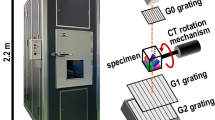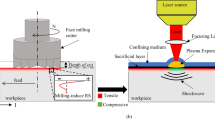Abstract
The in-plane method and the out-of-plane method are used to analyze blind-hole residual stress as measured by optical interferometry. The in-plane method, which constructs a relation between the in-plane displacement field and the residual stress released from blind-hole drilling, is applicable when the sensitivity vector of the interferometer used in the measuring system is parallel to the object surface. Three in-plane displacements obtained from one interference pattern are sufficient to determine the residual stress. The out-of-plane method, which establishes a new relation between the out-of-plane displacement field and the released residual stress, is suggested when the sensitivity vector is perpendicular to the object surface. Two relative out-of-plane displacements extracted from one interference pattern are sufficient to determine the residual stress. With the adoption of these two methods, interpolating calculation is not needed to determine the fringe order of each data point, since the selections of the required data points are flexible using these two methods. Two experiments, one for the in-plane method and the other for the out-of-plane method, were carried out to illustrate the applicability and usefulness of these two methods.
Similar content being viewed by others
References
Makino, A. andNelson, D., “Residual-stress Determination by Singleaxis Holographic Interferometry and Hole Drilling—Part I: Theory,” EXPERIMENTAL MECHANICS,34,67–78 (1994).
Nelson, D., Fuchs, E., Makino, A., andWilliams, D., “Residual-stress Determination by Single-axis Holographic Interferometry and Hole Drilling—Part II: Experiments,” EXPERIMENTAL MECHANICS,34,79–88 (1994).
Lin, S.T., Hsieh, C.T., andHu, C.P., “Two Holographic Blind-hole Methods for Measuring Residual Stresses,” EXPERIMENTAL MECHANICS,34,141–147 (1994).
Lin, S.T., Hsieh, C.T., andLee, C.K., “A General Form for Calculating Residual Stresses Detected by Using the Holographic Blind-hole Method,” EXPERIMENTAL MECHANICS,38,255–260 (1998).
Zienkiewicz, Q.C., The Finite Element Method, 3rd ed., McGraw-Hill, New York, chap. 15 (1977).
Schajer, G.S., “Application of Finite Element Calculations to Residual Stress Measurements,”ASME J. Eng. Mat. Tech.,103,157–163 (1981).
Schmitt, D.R. andLi, Y., “Three-dimensional Stress Relief Displacement Resulting from Drilling a Blind Hole in Acrylic,” EXPERIMENTAL MECHANICS,36,412–420 (1996).
Gere, J.M. and Timoshenko, S.P., Mechanics of Materials, 2nd ed., Wadsworth International, chap. 5 (1985).
Post, D., “Moiré Interferometry,”Handbook of Experimental Mechanics, A.S. Kobayashi, ed., Prentice Hall, Englewood Cliffs, NJ, 314–387 (1987).
Wang, Y. andChiang, F.P., “New Moiré Interferometry for Measuring Three-dimensional Displacements,”Opt. Eng.,33,2654–2658 (1994).
Matsumoto, T., Iwata, K., andNagata, R., “Measuring Accuracy of Three-dimensional Displacement in Holographic Interferometry,”Appl. Opt.,12,961–967 (1973).
Schajer, G.S., “Measurement of Non-uniform Residual Stresses Using the Hole-drilling Method. Part I-Stress Calculation Procedures,”Trans. ASME,110,338–343 (1988).
Makino, A. and Nelson, D.V., “Determination of Sub-surface Residual Stress Profiles by Holographic-hole Drilling Method,” Abstract Proceedings of the VIII International Congress on Experimental Mechanics and Experimental/Numerical Mechanics in Electronic Packaging, Nashville, TN (June 1996).
Vest, C.M., Holographic Interferometry, John Wiley, New York (1979).
Hung, Y.Y., Long, K.W., Wang, J.Q., and Hovanesian, J.D., “Automated Measurement of Residual Stress by Phase-shifting Shearography,” Abstract Proceedings of the VIII International Congress on Experimental Mechanics and Experimental/Numerical Mechanics in Electronic Packaging, Nashville, TN (June 1996).
Author information
Authors and Affiliations
Rights and permissions
About this article
Cite this article
Lin, S.T. Blind-hole residual stress determination using optical interferometry. Experimental Mechanics 40, 60–67 (2000). https://doi.org/10.1007/BF02327549
Received:
Revised:
Issue Date:
DOI: https://doi.org/10.1007/BF02327549




